Background:
Haemorrhage remains the top cause of death on the battlefield that could potentially be prevented. Despite advances in reducing overall battlefield mortality, there has been no significant improvement in survival rates for non-compressible torso haemorrhage (NCTH). The abdominal aortic junctional tourniquet-stabilised (AAJT-S) is a new intervention that could potentially address this issue and improve outcomes. This review systematically evaluates the safety and effectiveness of the AAJT-S for managing haemorrhage in prehospital combat situations.
Methods:
A comprehensive search of MEDLINE, Cumulated Index to Nursing and Allied Health Literature, and Embase databases (from inception to February 2022) was conducted, following the Preferred Reporting Items for Systematic Reviews and Meta-Analyses (PRISMA) guidelines. The search focused on English-language, peer-reviewed journal articles, excluding grey literature. Studies involving humans, animals, and experimental models were considered. All relevant papers were reviewed by the authors, and each study was evaluated for evidence quality and potential bias.
Findings:
Fourteen studies were included: seven controlled animal studies (total n=166), five studies involving healthy human volunteers (total n=251), one human case report, and one mannikin study. The AAJT-S effectively stopped blood flow in both human and animal studies when applied correctly. It was found to be simple to use by individuals with minimal training. Animal studies noted complications, primarily ischaemia-reperfusion injury, influenced by the duration of application. The evidence supporting the AAJT-S is limited due to the absence of randomised controlled trials and the overall low quality of available data.
Conclusions:
There is limited evidence regarding the safety and efficacy of the AAJT-S. Nonetheless, given the need for effective NCTH management solutions, the AAJT-S presents a promising option. However, due to the lack of strong evidence, its integration into clinical practice should be accompanied by a rigorous governance and monitoring framework, similar to practices used for resuscitative endovascular balloon occlusion of the aorta, with ongoing evaluation.


